Weekends: Sat & Sun, 3-18 Dec, 2022, 10am-4pm.
Other times by appointment: John (0418 318 620) or Chris (0418 512 471)
Artists
John Smith
Chris Johnston


Earthwork was opened by David Golightly on 3 December. Scroll down to read his talk.
Materiality & meaning
Earthwork celebrates the materiality of earth and the evocation of place through a series of paintings by John Smith juxtaposed with Chris Johnston’s ceramics. Both use earth as the foundation for their art.
John uses found and gathered materials to inscribe his paintings with the colours and textures of place, each being a map to and an expression of the nature of specific locations. Each painting starts with being in the place, with final refinements happening in the studio.
Chris combines the techniques of hand-building and throwing to create forms, surfaces and textures that engage with places or stories. She often works with multiple forms created as a series to express relationships or add to the potency of an idea.
About the Artists
John Smith
My paintings are highly textured abstract landscapes inspired by the places where the work is constructed.
This attempts to prove a map or a legend by creating symbols which characterise the place they came from.
These paintings are made of the earth itself, resembling a clay wall. They are made of clay, slate, sand and ochres that contain the colours of the earth or rock that surrounds me. My aim is to invite the viewer to experience a psychological connection to the landscape.
Find more of John’s work on Instagram and his website.
Chris Johnston
I work in earth materials – clay, both local and purchased – slips, terra sigillata and occasionally glazes to form fired clay works that reflect place connections.
This body of work extends from 2008 to today. Over that time, my experiences of the colour, land and stories of central Australia and our flinty goldfields region have featured, often through a series of thematic works.
Terra sigillata has become something of a signature. It is simply the finest clay particles washed onto the surface before firing, creating a natural sheen, often layered or counterpointed with textures. Ideas, words and stories are often the starting point for new work and I continue to be intrigued by enclosed forms and the idea of a hidden interior. But ultimately it is all about the clay.
EARTHWORK – Opening by David Golightly, 3 December 2022
This lovely exhibition of ceramics by Chris Johnston and paintings by John Smith is based partly on explorations of the landscape. The question can be asked: what more can be said about the landscape? Indeed, this question was put to students at an Australian university a few years ago by a British arts lecturer who exclaimed in exasperation “What is it about Australia and the landscape?!”
It could be said that Australia is so BIG, so OBVIOUS and so THERE. Given the Eurocentric eye that still persists in Australia it’s worth quoting Robert Hughes from the opening lines of his book The Fatal Shore:
‘In 1787, the twenty eighth year of the reign of King George III, the British government sent a fleet to colonise Australia. Never had a colony been founded so far from its parent state, or in such ignorance of the land it occupied. There had been no reconnaissance. In 1770 Captain James Cook had made landfall on the unexplored coast of this utterly enigmatic continent, stopped for a short while at a place named Botany Bay and gone north again. Since then no ship had called: not a word, not an observation, for seventeen years, each one of which was exactly like the thousands that had preceded it, locked it its historical immensity of blue heat, bush, sandstone and the measured booming of glassy pacific rollers.’
These lines seem to echo the continuing struggle to come to terms with such a vast and timeless continent and the colonial hangover which never quite goes away. In his book The Colonial Earth by Tim Bonyhady, a series of essays on colonialism, art and the environment, we learn that one of the essential pieces of equipment artists took with them on their painting forays into the interior was an axe. Necessary to cut down trees that were in the way of a good ‘view’.
There are several reasons why we have been able to shake off the ground level view of the landscape:
- the ability to view the land from the air
- the process of abstraction in art
- the lessons we have learned (and are still learning) about the relationship between the indigenous inhabitants of this country
Johnston has produced voluptuous ceramic forms that recollect monumental geographical features found in the heart of Australia. Not just with the soft, organic shapes but also the colours, textures and satin surfaces. Her works have the appearance of being viewed from a couple of thousand metres in the air.
These pieces contain stories that will remain unsaid as the Australian landscape contains thousands of years of stories and experiences that are palpable in the rocks, trees, soil, water air and animals. In other words: everywhere.
Smith has explored the abstract qualities of earth, undergrowth and millions of details found in the bush. His paintings could be vast tracts of land viewed from a plane or they could be close-ups of the undergrowth just a few millimetres from the surface.
He refers to his work as the ‘…calligraphy of site and place…’
Despite the mediums used by both artists being predominantly natural material – clay, iron, charcoal, ochres etc – there is a cleanness and serenity about this show. Well worth a look.
David Golightly, December 2022
